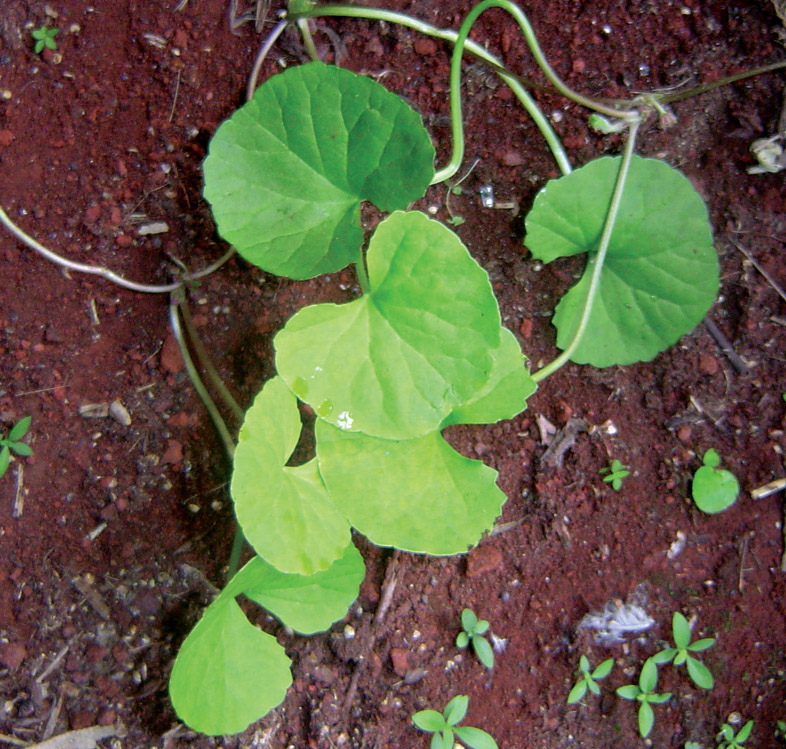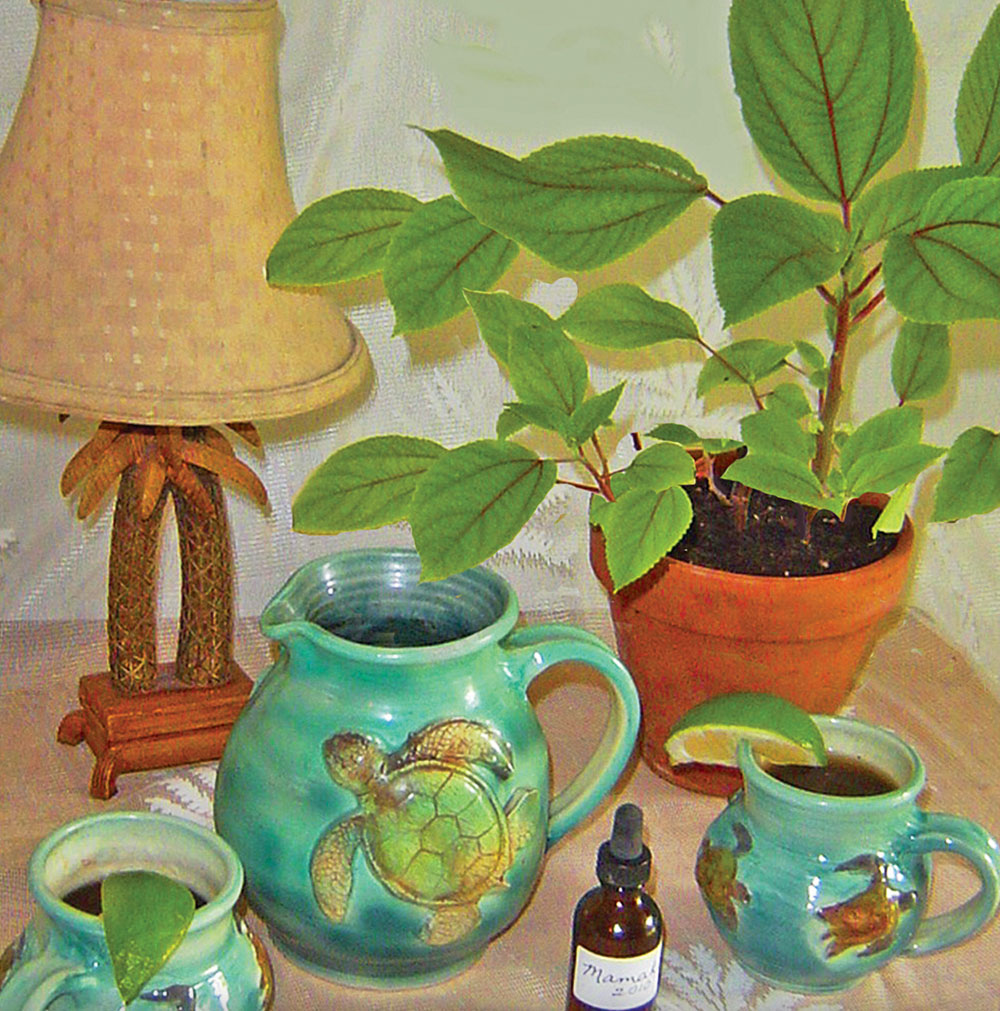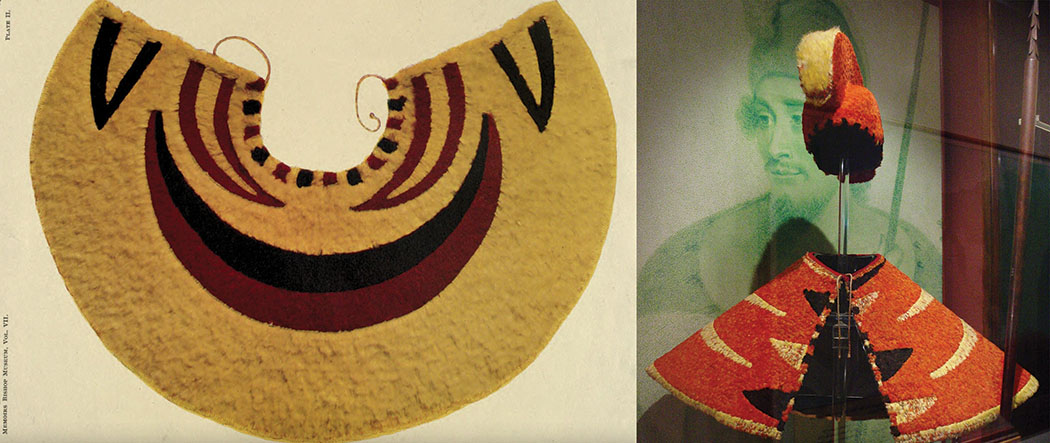
Healing Plants: Pohe Kula
 A small wild plant you want to remember
A small wild plant you want to remember
By Barbara Fahs
Having trouble remembering things? Perhaps you have taken Ginkgo biloba, a popular herbal supplement that is available at health food stores and pharmacies in easy-to-take capsule form. The website WebMD reports that this herb acts as an antioxidant that improves blood flow to the brain.
Gingko does not grow well in Hawai‘i, so if you want to try a local plant, consider gotu kola, called pohe kula in Hawaiian. This dainty little low-growing vine is known as Centella asiatica in the scientific world. Leaves are round, one inch across, with subtly scalloped edges. It’s related to carrots and parsley in the Apiales plant family. If you have a lawn, you might have unknowingly mowed away pohe kula plants, because it likes the moist lushness.

Pohe kula contains properties that make it useful for many ailments, such as serving to kill bacteria, and it has antiviral, anti-inflammatory, anti-ulcer, anti-anxiety, and wound healing properties. It also can act as a cerebral tonic, a circulatory stimulant, and a diuretic. It’s called “kūpuna medicine” due to its ability to improve the memory, which is its most common use.
It came to Western Polynesia from Asia thanks to early European explorers and spread east to Hawai‘i as other Polynesian peoples learned of its medicinal value. Little is known about its use in Hawai‘i during ancient times so we must study the ways other indigenous peoples used it. In his book Polynesian Herbal Medicine, Dr. Arthur Whistler says it was used in other parts of Polynesia to treat eye ailments, migraine headaches, and as a poultice for swellings and boils. Whistler states that it also contains an antibiotic used to treat leprosy. Since leprosy was introduced to Hawai‘i within recorded history due to infected whalers and sailors on the first ships to the islands, we know approximately when this use of pohe kula originated.
How To Take Pohe Kula
Look for gotu kola in natural foods stores in several forms: tea, tincture, and capsules. Capsules are the most convenient way to take this herb. Take it every day according to product label instructions.
If you are able to find and correctly identify pohe kula plants on your property, it’s easy to make tea or to add fresh leaves to your salads. Folklore suggests that eating six leaves every day will help to improve memory in time.
I prefer tea or tincture because I might forget to pick it and eat it every day.
To make tea, put 12 fresh leaves into a teacup and pour one cup of boiling water over them. Let steep for 10 minutes, then strain and drink three cups every day. You can make a large quantity and store it in your refrigerator.
Tinctures are also convenient and are easy to remember to take on a regular schedule. You can use either fresh or dried plant material—I prefer fresh whenever it’s available.
Here’s how to make a tincture:
- Place fresh or dried pohe kula leaves into a clean glass jar, filling it one-third full.
- Fill the jar with vodka or other alcohol, or choose apple cider vinegar or vegetable glycerin. Alcohol yields the strongest infusion.
- Tightly cap the jar, shake it up, and leave it in a shady area indoors for 30 days. Shake it every day, or as often as you remember.
- Strain the plant material from the liquid after 30 days. If you have a compost pile, it makes a fine addition.
- Store your tincture in a sturdy jar in a cool, dark place. If you like, transfer the finished liquid to small brown glass dropper-top bottles. No need to refrigerate.
- Take two to four droppers full of tincture two to three times each day. If you mix it with fruit juice, the flavor will be more agreeable.
Cautions
Avoid taking gotu kola during pregnancy. It might react negatively with blood thinning drugs such as aspirin, Coumadin, or Heparin. No toxicity has been reported, but monitor your health, and if you experience any adverse reactions, stop taking it immediately.
Lastly, the obvious caution—try not to forget to remember to take your pohe kula. ❖
Contact writer Barbara Fahs: hiiakas@lava.net
Sources:
- Herbal Remedies for Dummies, Christopher Hobbs
- Medicine At Your Feet, David Bruce Leonard
- Polynesian Herbal Medicine, Dr. Arthur Whistler
- University of Maryland: umm.edu/altmed/articles/gotu-kola-000253.htm
- webmd.com/vitamins-and-supplements/lifestyle-guide-11/supplement-guide-gotu-kola


